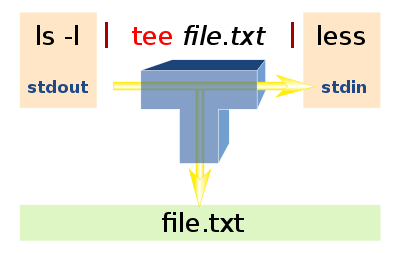简介
文件描述符是和文件的输入、输出相关联的非负整数,Linux内核(kernel)利用文件描述符(file descriptor)来访问文件。打开现存文件或新建文件时,内核会返回一个文件描述符。读写文件也需要使用文件描述符来指定待读写的文件。常见的文件描述符是stdin、stdout和stderr。
系统预留文件描述符
- 0 —— stdin(标准输入)
- 1 —— stdout(标准输出)
- 2 —— stderr(标准错误)
重定向将输入文本通过截取模式保存到文件:
1 | echo "this is a text line one" > test.txt |
重定向将输入文本通过追加模式保存到文件:
1 | echo "this is a text line one" >> test.txt |
标准错误输出:
1 | [root@localhost text]# cat linuxde.net |
标准错误输出的重定向方法:
1 | 方法一: |
将错误输出丢弃到/dev/null中,/dev/null是一个特殊的设备文件,这个文件接受到任何数据都会被丢系,通常被称为位桶、黑洞。
1 | [root@localhost text]# cat linuxde.net 2> /dev/null |
tee命令
tee命令可以将数据重定向到文件,另一方面还可以提供一份重定向数据的副本作为后续命令的stdin。

例子
在终端打印stdout同时重定向到文件中:1
2
3
4
5
6
7
8
9
10
11
12
13
14
15
16
17
18
19
20
21
22
23
24
25ls | tee out.txt
1.sh
1.txt
2.txt
eee.tst
EEE.tst
one
out.txt
string2
www.pdf
WWW.pdf
WWW.pef
显示行号
[root@localhost text]# ls | tee out.txt | cat -n
1 1.sh
2 1.txt
3 2.txt
4 eee.tst
5 EEE.tst
6 one
7 out.txt
8 string2
9 www.pdf
10 WWW.pdf
11 WWW.pef
重定向脚本内的文本片段(多行文本)
1 | !/bin/bash |
在cat <<EOF>text.log与下一个EOF行之间的所有文本都会当作stdin数据输入到text.log中。
自定义文件描述符
除了0、1和2分别是stdin、stdout和stderr的系统预留描述符,我们还可以使用exec命令创建自定义文件描述符,文件的的打开模式有只读模式、截断模式和追加模式。
< 操作符用于从文件中读取至stdin:
1 | echo this is a test line > input.txt |
> 操作符用于截断模式的文件写入(数据在文件内容被截断之后写入):
1 | exec 4>output.txt |
>> 操作符用于追加模式的文件写入(添加数据到文件中,原有数据不会丢失):
1 | exec 5>>output.txt |